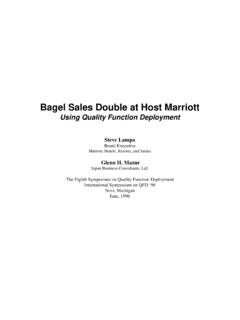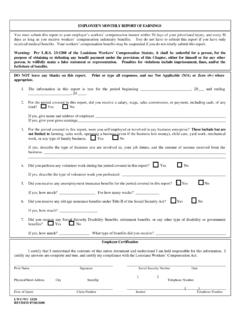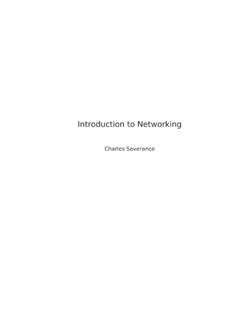Transcription of VOICE OF THE CUSTOMER (DEFINE) - Glenn Mazur
1 VOICE OF THE CUSTOMER ( define ): QFD TO define VALUE Glenn Mazur QFD Institute, University of Michigan 1140 Morehead Ct. Ann Arbor, MI 48103 SUMMARY Capture, rank and deploy the VOICE of the CUSTOMER and translate that VOICE into staff actions. Learn the principles and applications of Quality Function Deployment used by many leading organizations such as 3M, AT&T, Boeing, Chevron, DaimlerChrysler, EDS, Ford, General Motors, Gillette, Hewlett-Packard, Hughes, IBM, Jet Propulsion Laboratory, Kawasaki Heavy Industry, Kodak, Lockheed-Martin, Marriott, Motorola, NASA, NATO, NEC, Nissan Motors, Nokia, Pratt & Whitney, Proctor & Gamble, Raytheon, Sun Microsystems, Texas Instruments, Toshiba, Department of Defense, Visteon, Volvo, Xerox and many others.
2 INTRODUCTION What is Quality Function Deployment? Basically, QFD is designed to improve CUSTOMER satisfaction with the quality of our products and services. What can QFD do that is not already being done by traditional quality systems? To understand QFD, it is helpful to contrast the differences between modern and traditional quality systems. TRADITIONAL QUALITY SYSTEMS Traditional approaches to assuring quality often focus on work standards (Love 1986), automation to eliminate human error-prone processes, and in more enlightened organizations, Quality Improvement Teams to empower employees to resolve problems.
3 As organizations are finding out, however, consistency and absence of problems are not enough of a competitive advantage after the market shakes out suboptimal players. For example, in the automobile industry, despite the celebrated narrowing of the "quality" (read that fit and finish) gap between and Japanese makers, Japanese cars still win the top honors in the Powers Survey of New Car Quality. Suboptimal makers have all but disappeared from the North American market, the fit and finish of today s North American built vehicles are better than ever, but still the Japanese makes of Toyota, Nissan, and Honda grab top honors.
4 MODERN QUALITY SYSTEMS QFD differs from traditional quality systems which aim at minimizing negative quality (such as poor service, broken product). With traditional systems, the best you can get is nothing wrong - which is no longer good enough. In addition to eliminating negative quality, we must also maximize positive quality end-to-end throughout the organization. This creates value which leads to CUSTOMER satisfaction. Quality Function Deployment is the only comprehensive quality system aimed specifically at satisfying the CUSTOMER . It concentrates on maximizing CUSTOMER satisfaction (positive quality) by seeking out both spoken and unspoken needs, translating these into actions and designs, and communicating these throughout the organization end-to-end (Figure 1).
5 Further, QFD allows customers to prioritize their requirements, benchmark us against our competitors, and then direct us to optimize those aspects of our product, process, and organization that will bring the greatest competitive advantage. Nothing Wrong Anything Right Figure 1. QFD delivers value end-to-end. What business can afford to waste limited financial, time and human resources on things customers don't want? VOICE OF CUSTOMER In its earliest uses in the 1960s, QFD concerned itself primarily with end-to-end alignment of requirements throughout the organization. As internal business processes improved, QFD began to look upstream at where the requirements came from and where improvements could be made.
6 As a result, QFD invited the marketing and sales efforts, traditionally the most CUSTOMER oriented, to the join. In the ensuing years, QFD has devised numerous tools to bring this fuzzy front end into clearer focus. The following steps are now consistent with QFD Best Practice. 1. define and prioritize business or organizational goals. 2. define and prioritize CUSTOMER segments based on critical business goals. 3. Visit customers in situ, the gemba. Map their process. Gather verbatims. 4. Sort verbatims into appropriate dimensions of design and development. Translate verbatims into CUSTOMER needs positive statements of CUSTOMER benefit that are free of any implementation or solution.
7 5. Get CUSTOMER to structure the needs from his point of view, which can be different from the organization s. 6. Look for missing, unvoiced or latent needs. 7. Have CUSTOMER determine which needs are most important and how they measure their degree of satisfaction. 8. Translate top 1-3 CUSTOMER needs into functional requirements and develop solutions, end-to-end. 9. If necessary, benchmark preferred alternatives. 1. define AND PRIORITIZE BUSINESS OR ORGANIZATIONAL GOALS How will your project be judged? By whom? QFD and other cross-functional team members often serve, and are evaluated by, different organizational bosses.
8 Thus, team and business goals could differ from individual performance evaluation factors. Clarification of departmental and team goals is important so that neither customers nor team members are caught in the crossfire of internal battles. This step surfaces and prioritizes business goals for the project. Business or project goal analysis should be done early in the development cycle to assure alignment of cross-functional activities with what matters most to the business. The result should be better alignment of the team and better alignment of the management. There are many different kinds of QFD for many different kinds of projects.
9 While many of them have in common focus on satisfying a CUSTOMER , this is not always the case. That is why the QFD process must be tailored to the unique factors you face. The QFD Master Black Belt is trained to tailor QFD to the project needs. Business goals may vary according to one s organizational role. Be careful to distinguish between different kinds of goals. In QFD we may have Business Goals: profit, revenue, market share, brand Product Goals: performance, functionality, reliability Project Goals: on time, on budget, etc. 2. define AND PRIORITIZE CUSTOMER SEGMENTS BASED ON CRITICAL BUSINESS GOALS Which customers will help the project to be most successful?
10 A CUSTOMER is someone you have to satisfy to be successful or who can make you fail. define customers based on characteristics of use. These may be different than standard demographic attributes whose purpose is advertising and promotion. Our purpose here is product design, and so usability, functionality, and appearance issues need to be understood. The CUSTOMER Segments Table (Table 1) is a good tool for this. Which customers will help us most achieve our project goals? Are all customers equally important, or are some more valuable to us than others? Do we have limited resources (time, people, money) to visit customers?







